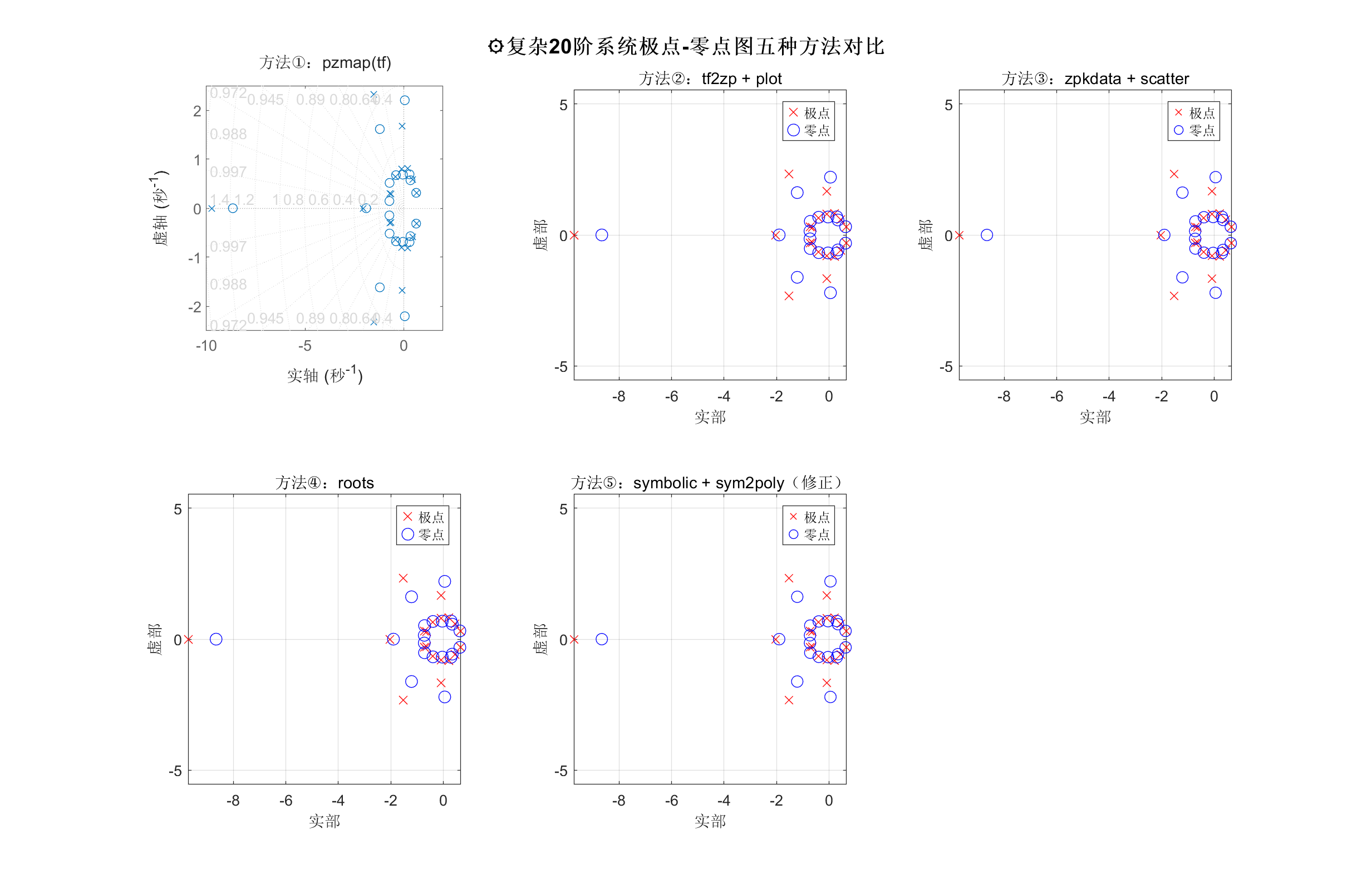以下是 MATLAB中绘制系统零极点图(Pole-Zero Map) 的常见方法及各自适用场景总结,适用于你当前在分析符号表达式/系统传函后的使用需求:
✅ 方法一:pzmap(tf(num, den)) (最常用,推荐)
📌 用法:
matlab
num_coeffs = sym2poly(num);
den_coeffs = sym2poly(den);
sys = tf(num_coeffs, den_coeffs);
pzmap(sys);✅ 优点:
- 容错性强:即使系统是常数、纯零阶、或奇异形式,也能画。
- 可用于 传递函数对象
tf。 - 支持绘制多个系统的极点/零点图叠加。
⚠️ 注意事项:
- 不返回零极点坐标,仅用于绘图。
✅ 方法二:[z, p, k] = tf2zp(num, den)(需要系数格式正确)
📌 用法:
matlab
[z, p, ~] = tf2zp(num_coeffs, den_coeffs);
plot(real(p), imag(p), 'x'); % 极点
plot(real(z), imag(z), 'o'); % 零点✅ 优点:
- 返回极点、零点的具体数值,适用于进一步处理或自定义绘图。
- 可与
plot()、scatter()等灵活搭配。
⚠️ 注意事项:
-
输入必须为一维行向量 ,不能含
NaN、Inf。 -
如果输入是符号表达式处理后得到的,需要使用:
matlabnum_coeffs = double(sym2poly(num(:).'));
✅ 方法三:[z, p, k] = zpkdata(tf(...), 'v')(稳定提取数值)
📌 用法:
matlab
sys = tf(num_coeffs, den_coeffs);
[z, p, ~] = zpkdata(sys, 'v');✅ 优点:
- 更鲁棒,不容易因为格式问题报错。
- 适合从传递函数对象中提取零极点数值。
⚠️ 注意事项:
- 需要用
tf(...)构造系统对象。
✅ 方法四:roots(num) 和 roots(den) (适合单独计算)
📌 用法:
matlab
z = roots(num_coeffs);
p = roots(den_coeffs);✅ 优点:
- 轻量级函数,只需计算零点/极点而不构造系统。
- 可用于系统分析或手动画图。
⚠️ 注意事项:
- 没有增益项
k,只适合基础分析。
✅ 方法五:符号工具箱方式(symbolic)
如果你的系统是符号表达式,可以先转换为多项式,再用上面方法处理:
matlab
[num, den] = numden(sym_expr); % 获取分子分母
num_coeffs = double(sym2poly(num)); % 多项式系数
den_coeffs = double(sym2poly(den));
[z, p, ~] = tf2zp(num_coeffs, den_coeffs);📊 方法选择建议对比表
| 方法 | 是否返回零极点数值 | 容错性 | 是否需要系统对象 | 推荐用途 |
|---|---|---|---|---|
pzmap(tf(...)) |
❌ | ✅✅✅ | ✅ | 快速画图 |
tf2zp(num, den) |
✅ | ⚠️ | ❌ | 精准提取零极点 |
zpkdata(tf(...)) |
✅ | ✅✅ | ✅ | 稳定提取零极点 |
roots(...) |
✅ | ✅ | ❌ | 只求零点或极点 |
符号方法 + sym2poly |
✅ | ⚠️⚠️ | ❌ | 从符号转数值 |
如你正在处理的是频率响应分析、稳定性边界研究、或者要对极点位置进行分类,建议用 tf2zp 或 zpkdata 提取后自行绘图、分区标色。也可以结合 scatter()、text() 自定义标注。
🎯 示例传递函数:
本文选用如下复杂的20阶传递函数作为统一实例:
H(s)=s20+14s19+65s18+⋯+10s+5s20+16s19+85s18+⋯+30s+10 H(s) = \frac{s^{20} + 14 s^{19} + 65 s^{18} + \cdots + 10 s + 5}{s^{20} + 16 s^{19} + 85 s^{18} + \cdots + 30 s + 10} H(s)=s20+16s19+85s18+⋯+30s+10s20+14s19+65s18+⋯+10s+5
其中分子和分母多项式系数均为给定的20阶多项式系数,充分体现了高阶系统零极点分析的复杂性。
matlab
clc; clear; close all;
% -----------------------------
% 构造符号多项式(20阶复杂多项式)
% -----------------------------
syms s
num_poly = s^20 + 14*s^19 + 65*s^18 + 210*s^17 + 500*s^16 + 900*s^15 + ...
1200*s^14 + 1100*s^13 + 900*s^12 + 700*s^11 + 500*s^10 + ...
300*s^9 + 200*s^8 + 150*s^7 + 120*s^6 + 90*s^5 + 60*s^4 + ...
40*s^3 + 20*s^2 + 10*s + 5;
den_poly = s^20 + 16*s^19 + 85*s^18 + 290*s^17 + 650*s^16 + 1100*s^15 + ...
1500*s^14 + 1400*s^13 + 1200*s^12 + 900*s^11 + 600*s^10 + ...
400*s^9 + 300*s^8 + 220*s^7 + 180*s^6 + 130*s^5 + 100*s^4 + ...
70*s^3 + 50*s^2 + 30*s + 10;
% -----------------------------
% 从符号多项式提取数值多项式系数(降幂顺序)
% -----------------------------
num_coeffs = double(coeffs(num_poly, s, 'All'));
den_coeffs = double(coeffs(den_poly, s, 'All'));
% 构造数值传递函数对象
sys_tf = tf(num_coeffs, den_coeffs);
% -----------------------------
% 创建图窗和子图
% -----------------------------
figure('Name','20阶系统极点零点图对比','Color','w','Position',[100 100 1200 800]);
% -----------------------------
% 方法一:pzmap
% -----------------------------
subplot(2,3,1);
pzmap(sys_tf);
title('方法①:pzmap(tf)');
grid on;
% -----------------------------
% 方法二:tf2zp
% -----------------------------
[z2, p2, ~] = tf2zp(num_coeffs, den_coeffs);
subplot(2,3,2);
plot(real(p2), imag(p2), 'rx', 'MarkerSize', 8); hold on;
plot(real(z2), imag(z2), 'bo', 'MarkerSize', 8);
title('方法②:tf2zp + plot');
xlabel('实部'); ylabel('虚部');
axis equal; grid on; legend('极点', '零点');
% -----------------------------
% 方法三:zpkdata
% -----------------------------
[z3, p3, ~] = zpkdata(sys_tf, 'v');
subplot(2,3,3);
scatter(real(p3), imag(p3), 60, 'r', 'x'); hold on;
scatter(real(z3), imag(z3), 60, 'b', 'o');
title('方法③:zpkdata + scatter');
xlabel('实部'); ylabel('虚部');
axis equal; grid on; box on; legend('极点', '零点');
% -----------------------------
% 方法四:roots
% -----------------------------
z4 = roots(num_coeffs);
p4 = roots(den_coeffs);
subplot(2,3,4);
plot(real(p4), imag(p4), 'rx', 'MarkerSize', 8); hold on;
plot(real(z4), imag(z4), 'bo', 'MarkerSize', 8);
title('方法④:roots');
xlabel('实部'); ylabel('虚部');
axis equal; grid on; legend('极点', '零点');
% 方法五:symbolic(修正后)
% -----------------------------
num_sym = poly2sym(num_coeffs, s);
den_sym = poly2sym(den_coeffs, s);
Hs_sym = num_sym / den_sym;
% 提取分子分母多项式
[num_numer, num_denom] = numden(Hs_sym);
% coeffs 默认返回升幂排列,需 flip 为降幂
num_coeffs_sym = double(flip(coeffs(num_numer, s)));
den_coeffs_sym = double(flip(coeffs(num_denom, s)));
% 计算零极点
z5 = roots(num_coeffs_sym);
p5 = roots(den_coeffs_sym);
subplot(2,3,5);
scatter(real(p5), imag(p5), 60, 'r', 'x'); hold on
scatter(real(z5), imag(z5), 60, 'b', 'o'); hold on;
title('方法⑤:symbolic + sym2poly(修正)');
xlabel('实部'); ylabel('虚部');
axis equal; grid on; box on; legend('极点','零点');
% -----------------------------
% 总标题
% -----------------------------
sgtitle('⚙复杂20阶系统极点-零点图五种方法对比', 'FontSize', 14, 'FontWeight', 'bold');
这段代码展示了五种绘制系统零极点的方法,各有优劣:
- 方法①(pzmap):调用方便,直接绘图,适合快速观察,但灵活性较低,图形大小和样式受限,无法直接获取极零点数据。
- 方法②(tf2zp):通过传递函数系数计算零极点,能够获得数值数据,便于自定义绘图,但对高阶多项式可能存在数值精度问题。
- 方法③(zpkdata):直接从系统对象获取零极点,精度高且简单,但要求传递函数对象格式正确。
- 方法④(roots):基于多项式根计算,灵活且通用,能处理任意多项式,但多项式系数的准确性对结果影响较大。
- 方法⑤(symbolic + sym2poly):利用符号计算避免数值误差,适合高精度需求,但计算速度较慢,代码复杂度较高。
综上,快速分析推荐方法①,精确数值计算推荐方法③或方法④,而方法⑤适合符号推导和高精度场景。根据具体需求灵活选择即可。